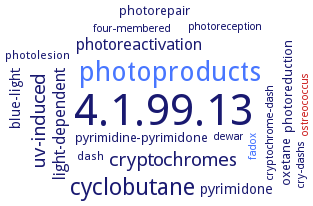4.1.99.13: (6-4)DNA photolyase
This is an abbreviated version!
For detailed information about (6-4)DNA photolyase, go to the full flat file.

Word Map on EC 4.1.99.13 
-
4.1.99.13
-
photoproducts
-
cyclobutane
-
uv-induced
-
cryptochromes
-
photoreactivation
-
light-dependent
-
pyrimidone
-
blue-light
-
photorepair
-
oxetane
-
pyrimidine-pyrimidone
-
photoreduction
-
photolesion
-
dash
-
ostreococcus
-
four-membered
-
fadox
-
photoreception
-
cry-dashs
-
dewar
-
cryptochrome-dash
- 4.1.99.13
- photoproducts
-
cyclobutane
-
uv-induced
-
cryptochromes
-
photoreactivation
-
light-dependent
-
pyrimidone
-
blue-light
-
photorepair
-
oxetane
-
pyrimidine-pyrimidone
-
photoreduction
-
photolesion
-
dash
- ostreococcus
-
four-membered
- fadox
-
photoreception
- cry-dashs
-
dewar
- cryptochrome-dash
Reaction
Synonyms
(6-4) DNA photolyase, (6-4) photolyase, (6-4) PHR, (6-4) PL, (6-4) PP-specific PL, (6-4)-Phr, (6-4)photolyase, 6-4 DNA photolyase, 6-4 photolyase, 6-4CiPhr, 6-4PP-photolyase, animal (6-4) photolyase, At64, At64PHR, bacterial (6-4) photolyase, CmPHR1, Cry1, CryB, deoxyribodipyrimidine photolyase-related protein, Dm64, DNA photolyase, Ds64PHR, H64PRH, human (6-4) photolyase homologous protein, NF-10, OtCPF1, phr (6-4), PhrB, PL-(6-4), prokaryotic (6-4) photolyase, RSP_3077, TRIREDRAFT_77473, XELAEV_18035355mg, Xl64phr
ECTree
Advanced search results
Systematic Name
Systematic Name on EC 4.1.99.13 - (6-4)DNA photolyase
Please wait a moment until all data is loaded. This message will disappear when all data is loaded.
(6-4) photoproduct pyrimidine-lyase
A flavoprotein (FAD). The overall repair reaction consists of two distinct steps, one of which is light-independent and the other one light-dependent. In the initial light-independent step, a 6-iminium ion is thought to be generated via proton transfer induced by two histidines highly conserved among the (6-4) photolyases. This intermediate spontaneously rearranges to form an oxetane intermediate by intramolecular nucleophilic attack. In the subsequent light-driven reaction, one electron is believed to be transferred from the fully reduced FAD cofactor (FADH-) to the oxetane intermediate thus forming a neutral FADH radical and an anionic oxetane radical, which spontaneously fractures. The excess electron is then back-transferred to the flavin radical restoring the fully reduced flavin cofactor and a pair of pyrimidine bases [2].


 results (
results ( results (
results ( top
top





